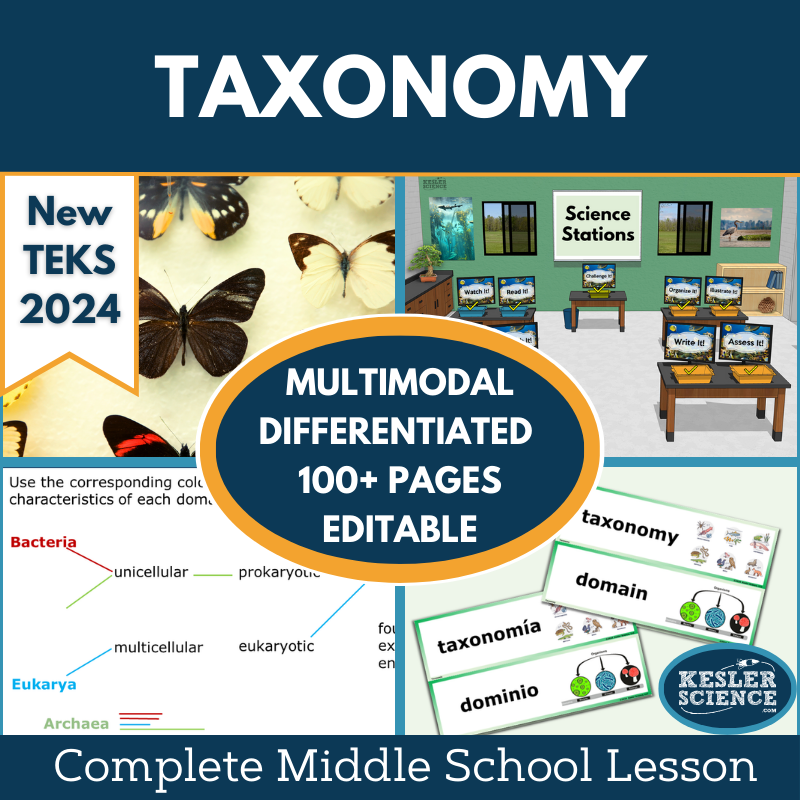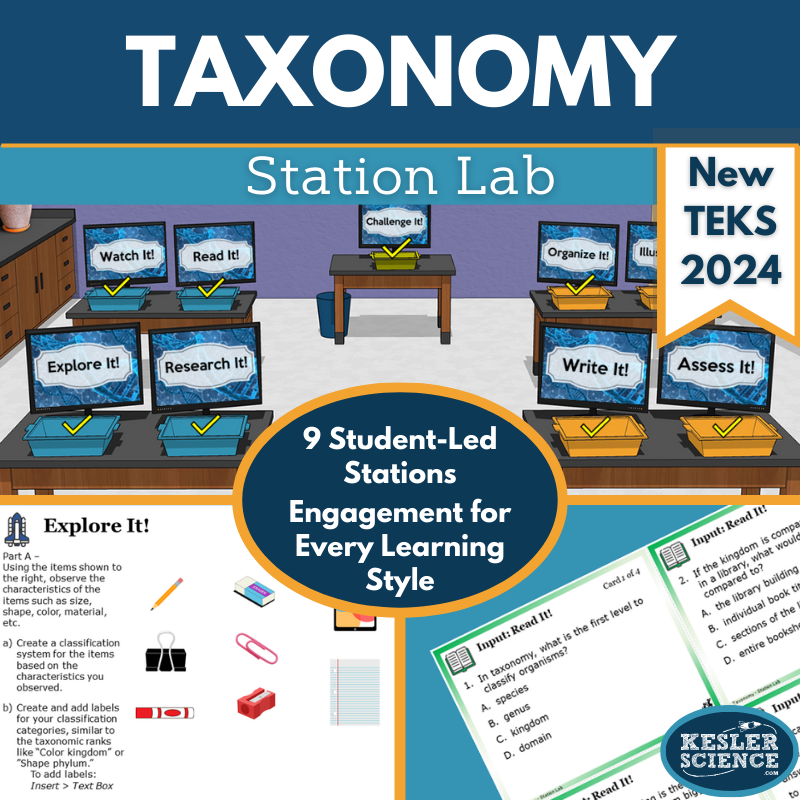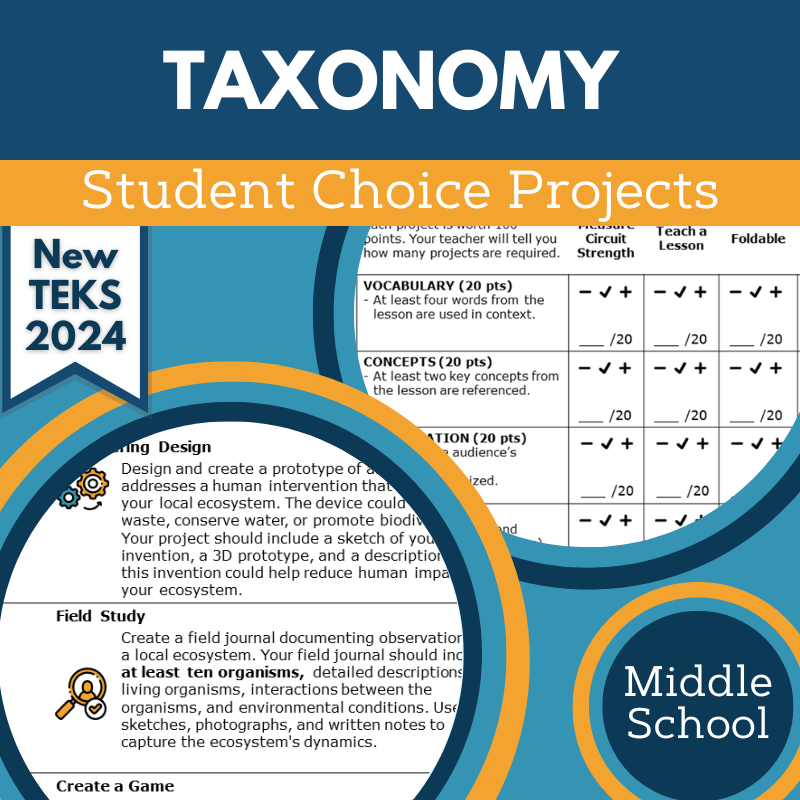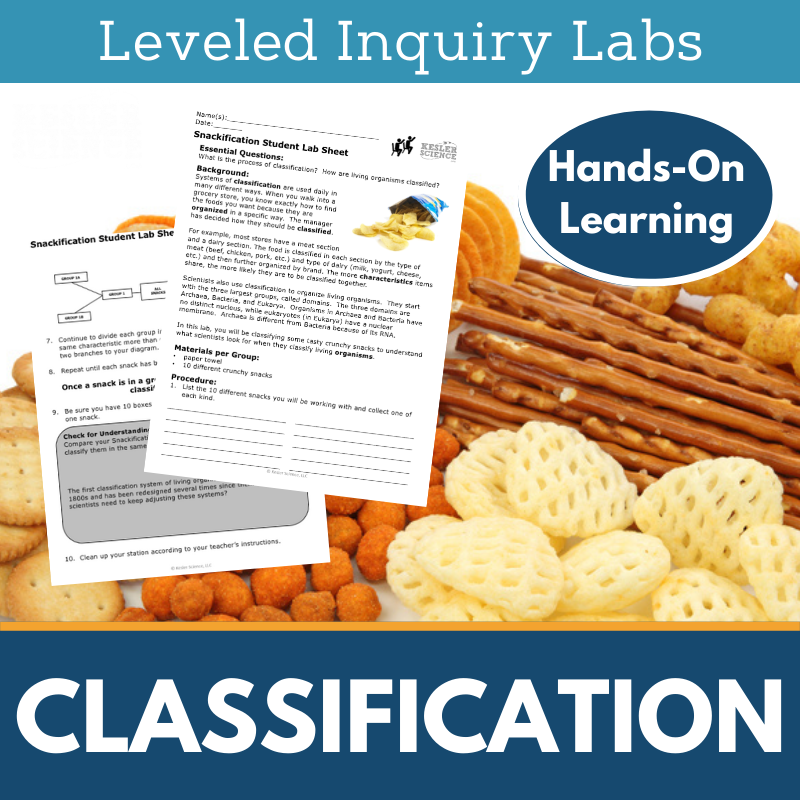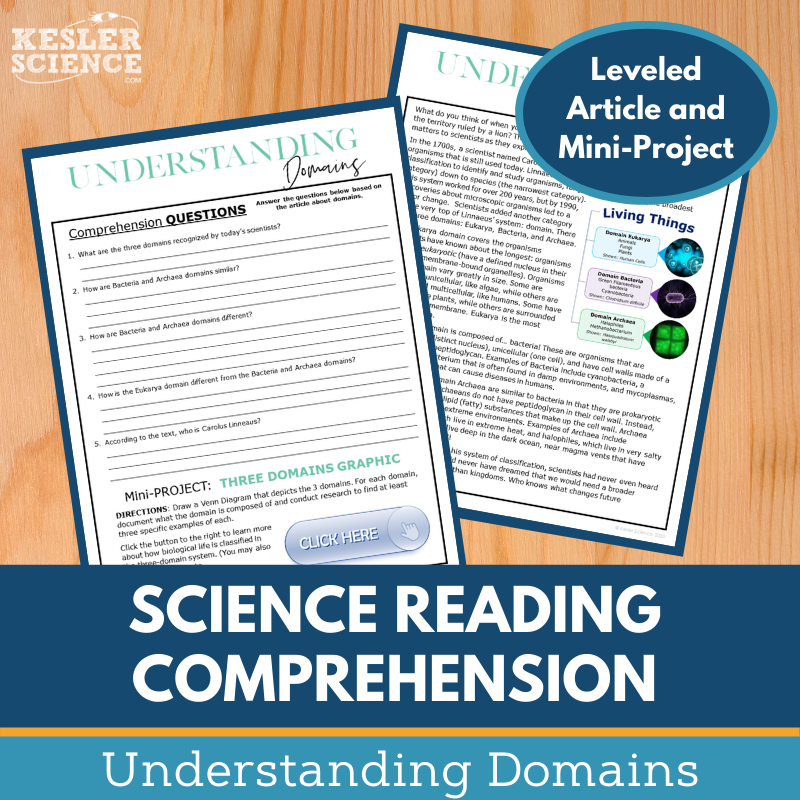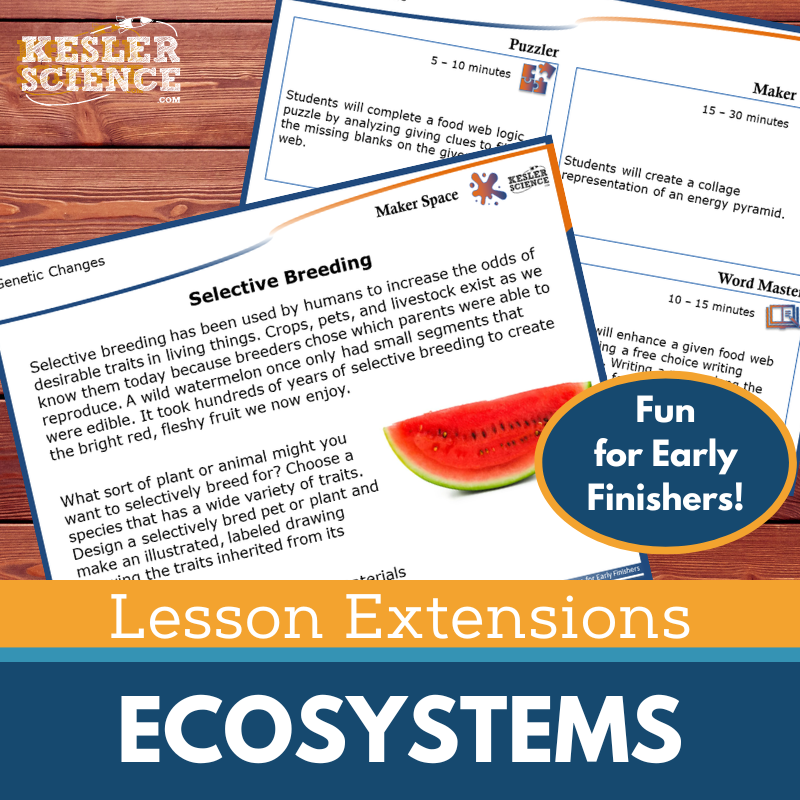Taxonomy Activities for Middle School Science
The Kesler Science Taxonomy 5E Lesson helps middle school students explore how organisms are classified based on similarities and differences. The resources below will give students a comprehensive understanding of taxonomy. All of the following materials are also included in the Kesler Science Membership.
The Kesler Science Taxonomy 5E Lesson is a comprehensive middle school unit designed to engage students in understanding how organisms are categorized based on similarities and differences. It includes editable PowerPoints, worksheets, choice projects, and assessments, all requiring minimal prep. The lesson is aligned with the 2021 TEKS 7.14A standard and supports differentiated, student-led learning.
Students explore the classification system through a hands-on, multimodal station lab with nine stations, offering interactive activities such as experiments, reading passages, research tasks, and video discussions. They demonstrate understanding through categorization exercises, writing prompts, illustrations, and formal assessments. The lesson includes editable PowerPoints, interactive notebook templates in English and Spanish, and note-taking guides. Students extend their learning through choice projects on taxonomy and classification.
Evaluation includes STAAR 2.0-aligned assessments, review questions, and worksheets for class discussion or homework. The lesson is fully adaptable for in-class and virtual learning environments, providing maximum flexibility with printable and digital formats.
The Kesler Science Taxonomy 5E Lesson is a comprehensive middle school unit designed to engage students in understanding how organisms are categorized based on similarities and differences. It includes editable PowerPoints, worksheets, choice projects, and assessments, all requiring minimal prep. The lesson is aligned with the 2021 TEKS 7.14A standard and supports differentiated, student-led learning.
Students explore the classification system through a hands-on, multimodal station lab with nine stations, offering interactive activities such as experiments, reading passages, research tasks, and video discussions. They demonstrate understanding through categorization exercises, writing prompts, illustrations, and formal assessments. The lesson includes editable PowerPoints, interactive notebook templates in English and Spanish, and note-taking guides. Students extend their learning through choice projects on taxonomy and classification.
Evaluation includes STAAR 2.0-aligned assessments, review questions, and worksheets for class discussion or homework. The lesson is fully adaptable for in-class and virtual learning environments, providing maximum flexibility with printable and digital formats.
Engage your middle school students with this student-led Taxonomy Station Lab aligned with the 2021 TEKS 7.14A standard. Designed for in-class or virtual learning, this lesson guides students as they explore the taxonomic system, classifying organisms based on shared similarities and differences.
Students engage with nine differentiated stations that allow for independent or small-group learning. Input stations introduce concepts through hands-on exploration, videos, readings with English and Spanish options, and research-based tasks. Output stations reinforce learning through activities like organizing manipulatives, sketching models, writing responses, and completing assessments. A challenge station offers extension activities such as crosswords, games, and mini projects.
This low-prep, high-engagement resource promotes active learning and critical thinking.
Engage your middle school students with this student-led Taxonomy Station Lab aligned with the 2021 TEKS 7.14A standard. Designed for in-class or virtual learning, this lesson guides students as they explore the taxonomic system, classifying organisms based on shared similarities and differences.
Students engage with nine differentiated stations that allow for independent or small-group learning. Input stations introduce concepts through hands-on exploration, videos, readings with English and Spanish options, and research-based tasks. Output stations reinforce learning through activities like organizing manipulatives, sketching models, writing responses, and completing assessments. A challenge station offers extension activities such as crosswords, games, and mini projects.
This low-prep, high-engagement resource promotes active learning and critical thinking.
The Taxonomy Student Choice Projects align with the 2021 TEKS standard 7.14A, giving middle school students the opportunity to select a project that matches their preferred output style. A project page outlines six student-led options plus a “design your own” project, with an editable rubric for teacher, peer, or self-assessment.
These flexible, multimodal projects allow students to creatively demonstrate their understanding. Two versions of the project page support differentiation, with modified options for students needing remediation and challenge options for advanced learners. Teachers can adjust the rubric to fit their grading needs.
The projects require standard classroom supplies such as paper, markers, and scissors, and many options can be completed digitally.
The Taxonomy Student Choice Projects align with the 2021 TEKS standard 7.14A, giving middle school students the opportunity to select a project that matches their preferred output style. A project page outlines six student-led options plus a “design your own” project, with an editable rubric for teacher, peer, or self-assessment.
These flexible, multimodal projects allow students to creatively demonstrate their understanding. Two versions of the project page support differentiation, with modified options for students needing remediation and challenge options for advanced learners. Teachers can adjust the rubric to fit their grading needs.
The projects require standard classroom supplies such as paper, markers, and scissors, and many options can be completed digitally.
The Classification System Inquiry Lab aligns with TEKS, helping students understand how scientists classify living organisms by developing their own system using crunchy snacks. This resource includes three differentiated labs to support diverse learners.
The structured, modified, and independent lab versions provide varying levels of guidance, allowing teachers to choose the best fit for their students. Editable teacher resource pages include standards, objectives, materials, and instructions. Reflection questions encourage students to develop claim, evidence, and reasoning statements, while answer keys assist with assessment.
Using simple materials like paper towels and a variety of crunchy snacks, this engaging hands-on activity deepens students' understanding of taxonomic classification.
The Classification System Inquiry Lab aligns with TEKS, helping students understand how scientists classify living organisms by developing their own system using crunchy snacks. This resource includes three differentiated labs to support diverse learners.
The structured, modified, and independent lab versions provide varying levels of guidance, allowing teachers to choose the best fit for their students. Editable teacher resource pages include standards, objectives, materials, and instructions. Reflection questions encourage students to develop claim, evidence, and reasoning statements, while answer keys assist with assessment.
Using simple materials like paper towels and a variety of crunchy snacks, this engaging hands-on activity deepens students' understanding of taxonomic classification.
The Classification Escape Room is an engaging activity where students apply their understanding of organism classification in an interactive way. Aligned with TEKS, this escape room challenges students to recognize domains and classify organisms based on key characteristics, such as cell type, structure, nutrition, and reproduction.
Teachers have full control over the eight independent puzzles, allowing flexibility based on class time and student needs. The escape room can be conducted using simple materials like manila envelopes or a more immersive setup with locks and a storage box. A digital version is available for individual student use via PowerPoint or Google Slides, with a printable option for home use.
The resource includes teacher directions, detailed answer keys, a digital answer sheet, video challenges, printable props, reward templates, and over 50 prize ideas. Students will be fully engaged in this interactive learning experience, making classification both fun and memorable!
The Classification Escape Room is an engaging activity where students apply their understanding of organism classification in an interactive way. Aligned with TEKS, this escape room challenges students to recognize domains and classify organisms based on key characteristics, such as cell type, structure, nutrition, and reproduction.
Teachers have full control over the eight independent puzzles, allowing flexibility based on class time and student needs. The escape room can be conducted using simple materials like manila envelopes or a more immersive setup with locks and a storage box. A digital version is available for individual student use via PowerPoint or Google Slides, with a printable option for home use.
The resource includes teacher directions, detailed answer keys, a digital answer sheet, video challenges, printable props, reward templates, and over 50 prize ideas. Students will be fully engaged in this interactive learning experience, making classification both fun and memorable!
This Science Reading Comprehension Passage helps students explore the taxonomic classification of living organisms by reading a nonfiction article and completing comprehension questions. They also create a graphic organizer comparing the three main domains. Designed for grades 6-8 (and advanced 5th graders), the leveled passage supports science literacy and reading comprehension.
The resource includes two leveled articles (Lexile 1100-1300), five to seven comprehension questions, a hands-on mini-project, and a Cornell notes template. Engaging, printable graphics enhance the experience, and the materials are suitable for both in-person and virtual learning through platforms like Google Classroom, MS Teams, Schoology, and Canvas.
Ideal for sub plans, extra credit, ISS, or whole-class instruction, this resource fosters critical thinking, classroom discussions, and textual analysis while reinforcing key concepts in taxonomic classification.
This Science Reading Comprehension Passage helps students explore the taxonomic classification of living organisms by reading a nonfiction article and completing comprehension questions. They also create a graphic organizer comparing the three main domains. Designed for grades 6-8 (and advanced 5th graders), the leveled passage supports science literacy and reading comprehension.
The resource includes two leveled articles (Lexile 1100-1300), five to seven comprehension questions, a hands-on mini-project, and a Cornell notes template. Engaging, printable graphics enhance the experience, and the materials are suitable for both in-person and virtual learning through platforms like Google Classroom, MS Teams, Schoology, and Canvas.
Ideal for sub plans, extra credit, ISS, or whole-class instruction, this resource fosters critical thinking, classroom discussions, and textual analysis while reinforcing key concepts in taxonomic classification.
The WIKI Tickets© Ecosystems Set provides engaging formative assessments for 6th-8th grade science, offering flexible ways to check student understanding. This set includes 20 assessments, each available in five formats: a full-screen display for projection, three printable handout versions, and an interactive digital format compatible with PowerPoint and Google Slides.
Aligned with NGSS and TEKS standards, these assessments cover key ecosystem topics such as biodiversity, biotic and abiotic factors, ecological succession, food webs, natural selection, and environmental impacts. Each standard has at least one corresponding ticket, with some topics featuring multiple assessments. A bonus table of contents file is included to show standard alignment.
Designed for both in-person and virtual learning, WIKI Tickets© can be used as exit tickets, bellringers, or quick checks. Students can respond on paper, interact with the projected version, or complete the digital format individually. These colorful, engaging assessments provide a ready-to-use tool for gauging student progress in any learning environment.
The WIKI Tickets© Ecosystems Set provides engaging formative assessments for 6th-8th grade science, offering flexible ways to check student understanding. This set includes 20 assessments, each available in five formats: a full-screen display for projection, three printable handout versions, and an interactive digital format compatible with PowerPoint and Google Slides.
Aligned with NGSS and TEKS standards, these assessments cover key ecosystem topics such as biodiversity, biotic and abiotic factors, ecological succession, food webs, natural selection, and environmental impacts. Each standard has at least one corresponding ticket, with some topics featuring multiple assessments. A bonus table of contents file is included to show standard alignment.
Designed for both in-person and virtual learning, WIKI Tickets© can be used as exit tickets, bellringers, or quick checks. Students can respond on paper, interact with the projected version, or complete the digital format individually. These colorful, engaging assessments provide a ready-to-use tool for gauging student progress in any learning environment.
Lesson Extensions provide engaging, student-choice activities designed to challenge early finishers and deepen their understanding of ecosystems. These activities encourage critical thinking and creativity, making them ideal for lesson wrap-ups, testing downtime, or keeping students engaged with rigorous yet enjoyable learning opportunities.
Each extension includes four interactive components: Puzzler for problem-solving, Maker Space for hands-on STEAM activities, Tech Connection for digital demonstrations, and Word Master for creative writing. With teacher directions, answer keys, and both print and projection versions, these extensions support independent learning and enrichment.
Covering topics such as biodiversity, ecosystem interactions, food webs, human impact, and photosynthesis, these extensions align with NGSS and TEKS standards, ensuring students explore ecosystems in a meaningful and engaging way.
Lesson Extensions provide engaging, student-choice activities designed to challenge early finishers and deepen their understanding of ecosystems. These activities encourage critical thinking and creativity, making them ideal for lesson wrap-ups, testing downtime, or keeping students engaged with rigorous yet enjoyable learning opportunities.
Each extension includes four interactive components: Puzzler for problem-solving, Maker Space for hands-on STEAM activities, Tech Connection for digital demonstrations, and Word Master for creative writing. With teacher directions, answer keys, and both print and projection versions, these extensions support independent learning and enrichment.
Covering topics such as biodiversity, ecosystem interactions, food webs, human impact, and photosynthesis, these extensions align with NGSS and TEKS standards, ensuring students explore ecosystems in a meaningful and engaging way.
This Amazing Anchors Phenomenon Lesson introduces classification and taxonomy through a real-world connection. It includes an introductory reading on classification with comprehension and extension questions to prepare students for further learning, followed by an explanatory reading that breaks down the science behind classification and taxonomy in an accessible way. Additional comprehension and reinforcement questions help deepen understanding.
Aligned with TEKS, this no-prep resource includes teacher directions with answer keys, projection slides, and both print and digital formats for Google Classroom and other LMS platforms. A differentiated version provides sentence starters for student support. Designed to bookend a lesson, these engaging readings serve as supplements to reinforce learning in any in-person or virtual classroom.
This Amazing Anchors Phenomenon Lesson introduces classification and taxonomy through a real-world connection. It includes an introductory reading on classification with comprehension and extension questions to prepare students for further learning, followed by an explanatory reading that breaks down the science behind classification and taxonomy in an accessible way. Additional comprehension and reinforcement questions help deepen understanding.
Aligned with TEKS, this no-prep resource includes teacher directions with answer keys, projection slides, and both print and digital formats for Google Classroom and other LMS platforms. A differentiated version provides sentence starters for student support. Designed to bookend a lesson, these engaging readings serve as supplements to reinforce learning in any in-person or virtual classroom.
Year-Round Resources
These year-round activities will increase your students' understanding of many middle school science topics. All of these activities are also included in the Kesler Science Membership.
Visual Data & Graphing
You're not alone if your students struggle with understanding graphs, charts, and tables. It's a skill that takes an enormous amount of practice. This resource will help students build a strong foundation in analyzing data and creating their own data visualizations.
Bell Ringers and Warm-Ups
These middle school science bell ringers are an excellent way to engage your students as soon as they walk into your classroom. This comprehensive FULL YEAR resource includes everything you need to start off each science class with an interesting warm-up activity.
Review Board Games
Each game board has been carefully designed to keep students engaged. There are 10 different action spaces on each board and dozens of question cards. All of the actions are related to science concepts and keep the students motivated throughout the game.
Each game is ready to play. Simply print out the board and the cards and let the students enjoy reviewing nine different units.
Essential Questions and Standards
Below are the essential questions and standards associated with the lessons and activities included in the atoms unit. This topic is only one of more than 100 middle school science topics included in the Kesler Science Membership.
-
How does the taxonomic system organize living organisms based on similarities and differences?
-
What are the key criteria used to categorize organisms into different taxonomic levels?
-
TEKS Science - 7.14A Taxonomy
Kesler Science Membership
Imagine never having to search for another middle school science lesson again. The membership gives you access to ALL of the Kesler Science products in one place (Yes, including everything above).
Say goodbye to long hours of lesson prep.

